Prehistoric Crete
Some of the early influences upon the development of Cretan culture arise from the Cyclades and from Egypt; cultural records are written in the undeciphered script known as "Linear A". The archaeological record of Crete includes superb palaces, houses, roads, paintings and sculptures. Early Neolithic settlements in Crete include Knossos and Trapeza.
Cretan history is surrounded by myths (such as those of the king Minos; Theseus and the Minotaur; and Daedalus and Icarus) that have been passed to us via Greek historian/poets (such as Homer).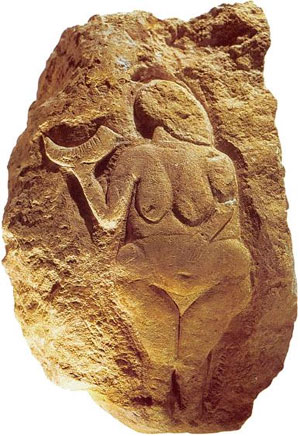 Because of a lack of written records, estimates of Cretan chronology are based on well-established Aegean and Ancient Near Eastern pottery styles, so that Cretan timelines have been made by seeking Cretan artifacts traded with other civilizations (such as the Egyptians) - a well established occurrence. For the earlier times, radiocarbon dating of organic remains and charcoal offers independent dates. Based on this, it is thought that Crete was inhabited from the 7th millennium BC onwards. The fall of Knossos took place circa 15th century BC. Subsequently Crete was controlled by the Mycenaeans from mainland Greece.
Because of a lack of written records, estimates of Cretan chronology are based on well-established Aegean and Ancient Near Eastern pottery styles, so that Cretan timelines have been made by seeking Cretan artifacts traded with other civilizations (such as the Egyptians) - a well established occurrence. For the earlier times, radiocarbon dating of organic remains and charcoal offers independent dates. Based on this, it is thought that Crete was inhabited from the 7th millennium BC onwards. The fall of Knossos took place circa 15th century BC. Subsequently Crete was controlled by the Mycenaeans from mainland Greece.
The first human settlement in Crete dates to the aceramic Neolithic. There have been some claims for Palaeolithic remains, none of them very convincing. The finds from Samaria-gorge, identified as Mesolithic by some scholars, seem to be the product of trampling. The native fauna of Crete included pygmy hippo, pygmy elephant, dwarf deer (Praemegaceros cretensis), giant rodents and insectivores as well as badger, beech marten and a kind of terrestrial otter. Large carnivores were lacking. Most of these animals died out at the end of the last ice-age. Humans played a part in this extinction, which occurred on other medium to large Mediterranean islands as well, for example on Cyprus, Sicily and Majorca. Crete's religious symbols included the dove, lily and double-headed ax.
Remains of a settlement found under the Bronze Age palace at Knossos (layer X) date to the 7th Millennium BC
The first settlers introduced cattle, sheep, goats, pigs, and dogs, as well as domesticated cereals and legumes.
Up to now, Knossos remains the only aceramic site. The settlement covered approximately 350,000 square metres. The sparse animal bones contain the above-mentioned domestic species as well as deer, badger, marten and mouse: the extinction of the local megafauna had not left much game behind.
Neolithic pottery is known from Knossos, Lera Cave and Gerani Cave. The Late Neolithic sees a proliferation of sites, pointing to a population increase. In the late Neolithic, the donkey and the rabbit were introduced to the island, deer and agrimi hunted. The agrimi, a feral goat, preserves traits of the early domesticates. Horse, fallow deer and hedgehog are only attested from Minoan times onwards.
Minoan-Mycenaean Crete
Crete was the centre of Europe's most ancient civilization, the Minoan. Tablets inscribed in Linear A have been found in numerous sites in Crete, and a few in the Aegean islands. The Minoans established themselves in many islands besides Ancient Crete: secure identifications of Minoan off-island sites include Kea, Kythera, Milos, Rhodes, and above all, Thera (Santorini).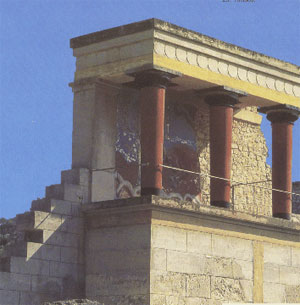
Archaeologists ever since Sir Arthur Evans have identified and uncovered the palace-complex at Knossos, the most famous Minoan site. Other palace sites in Crete such as Phaistos have uncovered magnificent stone-built, multi-story palaces containing drainage systems,[1] and the queen had a bath and a flushing toilet. The expertise displayed in the hydraulic engineering was of a very high level. There were no defensive walls to the complexes. By the 16th century BC pottery and other remains on the Greek mainland show that the Minoans had far-reaching contacts on the mainland. In the 16th century a major earthquake caused destruction on Crete and on Thera that was swiftly repaired.
By about the 15th century BC a massive volcanic explosion known as the Minoan eruption blew the island of Thera apart, casting more than four times the amount of ejecta as the explosion of Krakatoa and generating a tsunami in the enclosed Aegean that threw pumice up to 250 meters above sea level onto the slopes of Anaphi, 27 km to the east. Any fleet along the north shore of Crete was destroyed and John Chadwick suggests that the majority of Cretan fleets had kept the island secure from the Greek-speaking mainlanders. The sites, save Knossos, were destroyed by fires. Mycenaeans from the mainland took over Knossos, rebuilding some parts to suit them. They were in turn subsumed by a subsequent Dorian migration.
Classical, Hellenistic, Roman, Byzantine and Arab Crete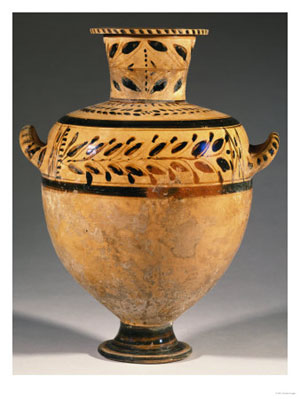 In the Classical and Hellenistic period Crete fell into a pattern of combative city-states, harboring pirates. Gortyn, Kydonia (Chania) and Lyttos challenged the primacy of ancient Knossos, preyed upon one another, invited into their feuds mainland powers like Macedon and its rivals Rhodes and Ptolemaic Egypt, a situation that all but invited Roman interference. Ierapytna (Ierapetra) gained supremacy on eastern Crete.
In the Classical and Hellenistic period Crete fell into a pattern of combative city-states, harboring pirates. Gortyn, Kydonia (Chania) and Lyttos challenged the primacy of ancient Knossos, preyed upon one another, invited into their feuds mainland powers like Macedon and its rivals Rhodes and Ptolemaic Egypt, a situation that all but invited Roman interference. Ierapytna (Ierapetra) gained supremacy on eastern Crete.
In 88 BC Mithridates VI of Pontus on the Black Sea, went to war to halt the advance of Roman hegemony in the Aegean. On the pretext that Knossos was backing Mithradates, Marcus Antonius Creticus attacked Crete in 71 BC and was repelled. Rome sent Quintus Caecilius Metellus with three legions to the island. After a ferocious three-year campaign Crete was conquered for Rome in 69 BC, earning this Metellus the agnomen "Creticus." At the archaeological sites, there seems to be little evidence of widespread damage associated with the transfer to Roman power: a single palatial house complex seems to have been razed. Gortyn seems to have been pro-Roman and was rewarded by being made the capital of a province that at times joined Cyrenaica to Crete.
Gortyn was the site of the largest Christian basilica on Crete, the Basilica of Ayios Titos dedicated to Saint Titus, the first Christian bishop in Crete, to whom Paul addressed one of his epistles. The church was begun in the 5th century. As revealed in the Epistle to Titus in the New Testament and confirmed by Cretan poet Epimenides the people of Crete were considered by these Christians to be liars and gluttons. (Note: Epimenides was a 6th century poet. Paul cited him in Titus, but he cannot be said to confirm anything)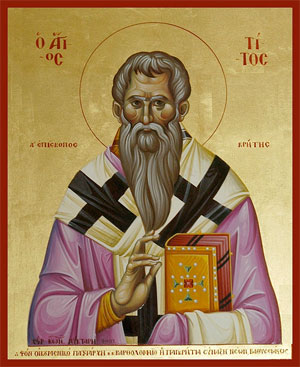 Crete continued to be part of the Eastern Roman or Byzantine empire, a quiet cultural backwater, until it fell into the hands of Iberian Muslims under Abu Hafs in the 820s, who established a piratical emirate on the island. The archbishop of Gortyn (Cyril) was assassinated and the city so thoroughly devastated it was never reoccupied. Candia (Chandax, modern Heraklion), a city built by the Iberian Muslims, was made capital of the island instead.
Crete continued to be part of the Eastern Roman or Byzantine empire, a quiet cultural backwater, until it fell into the hands of Iberian Muslims under Abu Hafs in the 820s, who established a piratical emirate on the island. The archbishop of Gortyn (Cyril) was assassinated and the city so thoroughly devastated it was never reoccupied. Candia (Chandax, modern Heraklion), a city built by the Iberian Muslims, was made capital of the island instead.
The Emirate of Crete became a center of Muslim piratical activity in the Aegean, and a thorn on Byzantium's side. Successive campaigns to recover the island failed until 961, when Nicephorus Phocas reconquered Crete for the Byzantines. They held it until 1204, when it fell into the hands of the Venetians at the time of the Fourth Crusade. The Venetians retained the island until 1669, when the Ottoman Turks took possession of it.
Venetian and Ottoman Crete
In the partition of the Byzantine empire after the capture of Constantinople by the armies of the Fourth Crusade in 1204, Crete was eventually acquired by Venice, which held it for more than four centuries (the "Kingdom of Candia").
The most important of the many rebellions that broke out during that period was the one known as the revolt of St. Titus. It occurred in 1363, when indigenous Cretans and Venetian settlers exasperated by the hard tax policy exercised by Venice, overthrew official Venetian authorities and declared an independent Cretan Republic. The revolt took Venice five years to quell.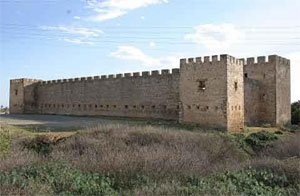 During Venetian rule, the Greek population of Crete was exposed to Renaissance culture. A thriving literature in the Cretan dialect of Greek developed on the island. The best-known work from this period is the poem Erotokritos by Vitsentzos Kornaros (Βιτσένζος Κορνάρος). Another major Cretan literary figure was Nicholas Kalliakis (1645–1707), a Greek scholar and philosopher who flourished in Italy in the 17th Century. Georgios Hortatzis was author of the dramatic work Erophile. The painter Domenicos Theotocopoulos, better known as El Greco, was born in Crete in this period and was trained in Byzantine iconography before moving to Italy and later, Spain.
During Venetian rule, the Greek population of Crete was exposed to Renaissance culture. A thriving literature in the Cretan dialect of Greek developed on the island. The best-known work from this period is the poem Erotokritos by Vitsentzos Kornaros (Βιτσένζος Κορνάρος). Another major Cretan literary figure was Nicholas Kalliakis (1645–1707), a Greek scholar and philosopher who flourished in Italy in the 17th Century. Georgios Hortatzis was author of the dramatic work Erophile. The painter Domenicos Theotocopoulos, better known as El Greco, was born in Crete in this period and was trained in Byzantine iconography before moving to Italy and later, Spain.
During the Cretan War (1645–1669), Venice was pushed out of Crete by the Ottoman Empire, with most of the island lost after the siege of Candia (1648–1669), possibly the longest siege in history. The last Venetian outpost on the island, Spinalonga, fell in 1718, and Crete was a part of the Ottoman Empire for the next two centuries. There were significant rebellions against Ottoman rule, particularly in Sfakia. Daskalogiannis was a famous rebel leader. One result of the Ottoman conquest was that a sizeable proportion of the population gradually converted to Islam, with its tax and other civic advantages in the Ottoman system. Contemporary estimates vary, but on the eve of the Greek War of Independence as much as 45% of the population of the island may have been Muslim. Some of them were crypto-Christians who converted back to Christianity; others fled Crete because of the unrest. By the last Ottoman census in 1881, Christians were 76% of the population, and Muslims (usually called "Turks" regardless of language, culture, and ancestry) only 24%. Christians were over 90% of the population in 19/23 of the districts of Crete, but Muslims were over 60% in the three large towns on the north coast, and in Monofatsi. The Greek War of Independence began in 1821 and Cretan participation was extensive. An uprising by Christians met with a fierce response from the Ottoman authorities and the execution of several bishops, regarded as ringleaders. Between 1821 and 1828, the island was the scene of repeated hostilities. The Muslims were driven into the large fortified towns on the north coast and it would appear that as many as 60% of them died from plague or famine while there. The Cretan Christians also suffered severely, losing around 21% of their population. In the 1830s.
As the Ottoman sultan, Mahmud II, had no army of his own available, he was forced to seek the aid of his rebellious vassal and rival, Muhammad Ali of Egypt, who sent an expedition to the island. Britain decided that Crete should not become part of the new Kingdom of Greece on its independence in 1830, evidently fearing that it would either become a centre of piracy as it had often been in the past, or a Russian naval base in the East Mediterranean. In 1832, a Greek state was established which, however, did not include Crete; the island was administered by an Albanian from Egypt, Giritli Mustafa Naili Pasha (known as Mustafa Pasha), whose rule attempted to create a synthesis of Muslim landowners and the emergent Christian commercial classes. Though subsequent Greek nationalist historiography has portrayed the Pasha as an oppressive figure, as reported by British and French consular observers, he seems to have been generally cautious, pro-British, and to have tried harder to win the support of the Cretan Christians (having married the daughter of a priest and allowed her to remain Christian) than the Cretan Muslims. In 1834 however a Cretan committee was set up in Athens to work for the union of the island with Greece.
In 1840, Egypt was forced by Palmerston to return Crete to direct Ottoman rule. Mustafa Pasha angled unsuccessfully to become semi-independent Prince of Greece but the Christian Cretans instead of supporting rose up against him, once more driving the Muslims temporarily into siege in the towns. An Anglo-Ottoman naval operation restored control in the island and Mustafa Pasha was confirmed as the governor of the island, though under command from Istanbul. He remained there until 1851 when he was summoned to Istanbul, where though of relatively advanced age (his early fifties) he had a successful career, becoming Grand Vizier several times.
Modern Crete
After Greece achieved its independence, Crete became an object of contention as the Christian part of its population revolted several times against Ottoman rule. Revolts in 1841 and 1858 secured some privileges, such as the right to bear arms,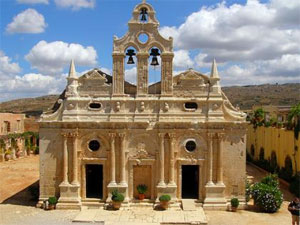 equality of Christian and Muslim worship, and the establishment of Christian councils of elders with jurisdiction over education and customary law. Despite these concessions, the Christian Cretans maintained their ultimate aim of union with Greece, and tensions between the Christian and Muslim communities ran high. Thus, in 1866 the great Cretan Revolt began.
equality of Christian and Muslim worship, and the establishment of Christian councils of elders with jurisdiction over education and customary law. Despite these concessions, the Christian Cretans maintained their ultimate aim of union with Greece, and tensions between the Christian and Muslim communities ran high. Thus, in 1866 the great Cretan Revolt began.
The uprising, which lasted for three years, involved volunteers from Greece and other European countries, where it was viewed with considerable sympathy. Despite early successes of the rebels, who quickly confined the Ottomans to the northern towns, the uprising failed. The Ottoman Grand Vizier A'ali Pasha personally assumed control of the Ottoman forces and launched a methodical campaign to retake the rural districts, which was combined with promises of political concessions, notably by the introduction of an Organic Law, which gave the Cretan Christians equal (in practice, because of their superior numbers, majority) control of local administration. His approach bore fruits, as the rebel leaders gradually submitted. By early 1869, the island was again under Ottoman control.
During the Congress of Berlin in the summer of 1878, there was a further rebellion, which was halted quickly by the intervention of the British and the adaptation of the 1867-8 Organic Law into a constitutional settlement known as the Pact of Halepa. Crete became a semi-independent parliamentary state within the Ottoman Empire under an Ottoman Governor who had to be a Christian. A number of the senior "Christian Pashas" including Photiades Pasha and Kostis Adosidis Pasha ruled the island in the 1880s, presiding over a parliament in which liberals and conservatives contended for power. Disputes between the two powers however led to a further insurgency in 1889 and the collapse of the Pact of Halepa arrangements. The international powers, disgusted at what seemed to be factional politics, allowed the Ottoman authorities to send troops to the island and restore order but did not anticipate that Ottoman Sultan Abdul Hamid II would use this as a pretext to end the Halepa Pact Constitution and instead rule the island by martial-law. This action led to international sympathy for the Cretan Christians and to a loss of any remaining acquiescence among them for continued Ottoman rule. When a small insurgency began in September 1895, it spread quickly, and by the summer of 1896 the Ottoman orces had lost military control of most of the island.
Cretan State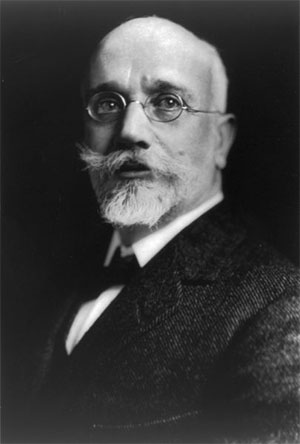 A new Cretan insurrection in 1897 led to the Ottoman Empire declaring war on Greece. However, the Great Powers (Britain, France, Italy and Russia) decided that Turkey could no longer maintain control and intervened. By March 1897, the Great Powers decided to restore order by governing the island temporarily through a committee of four admirals who remained in charge until the arrival of Prince George of Greece as first governor-general of an autonomous Crete, effectively detached from the Ottoman Empire, on 9 December 1898. Turkish forces were expelled in 1898, and the independent Cretan State (Official Greek name: Κρητική Πολιτεία), headed by Prince George of Greece, was founded.
A new Cretan insurrection in 1897 led to the Ottoman Empire declaring war on Greece. However, the Great Powers (Britain, France, Italy and Russia) decided that Turkey could no longer maintain control and intervened. By March 1897, the Great Powers decided to restore order by governing the island temporarily through a committee of four admirals who remained in charge until the arrival of Prince George of Greece as first governor-general of an autonomous Crete, effectively detached from the Ottoman Empire, on 9 December 1898. Turkish forces were expelled in 1898, and the independent Cretan State (Official Greek name: Κρητική Πολιτεία), headed by Prince George of Greece, was founded.
Prince George was replaced by Alexandros Zaimis in 1906, and in 1908, taking advantage of domestic turmoil in Turkey as well as the timing of Zaimis's vacation away from the island, the Cretan deputies declared union with Greece. But this act was not recognized internationally until 1913 after the Balkan Wars. By the Treaty of London, Sultan Mehmed V relinquished his formal rights to the island. In December, the Greek flag was raised at the Firkas fortress in Chania, with Eleftherios Venizelos and King Constantine in attendance, and Crete was unified with mainland Greece. The Muslim minority of Crete initially remained in the island but was later relocated to Turkey under the general population exchange agreed in the 1923 Treaty of Lausanne between Turkey and Greece.
One of the most important figures to emerge from the end of Ottoman Crete was the liberal politician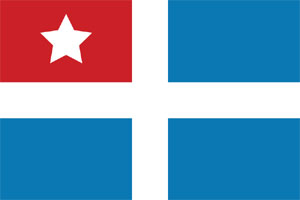 Eleftherios Venizelos, probably the most important statesman of modern Greece. Venizelos was an Athens-trained lawyer who was active in liberal circles in Hania, then the Cretan capital. After autonomy, he was first a minister in the government of Prince George and then his most formidable opponent. In 1910 Venizelos transferred his career to Athens, quickly became the dominant figure on the political scene and in 1912, after careful preparations for a military alliance against the Ottoman Empire with Serbia, Montenegro, and Bulgaria, allowed Cretan deputies to take their place in the Greek Parliament. This was treated as grounds for war by Turkey but the Balkan allies won a series of sweeping victories in the hostilities that followed (see Balkan Wars). The Turks were effectively defeated in the ensuing war and were forced out of the Balkans and Thrace by the Alliance, except for the borders which Turkey continues to hold to this day.
Eleftherios Venizelos, probably the most important statesman of modern Greece. Venizelos was an Athens-trained lawyer who was active in liberal circles in Hania, then the Cretan capital. After autonomy, he was first a minister in the government of Prince George and then his most formidable opponent. In 1910 Venizelos transferred his career to Athens, quickly became the dominant figure on the political scene and in 1912, after careful preparations for a military alliance against the Ottoman Empire with Serbia, Montenegro, and Bulgaria, allowed Cretan deputies to take their place in the Greek Parliament. This was treated as grounds for war by Turkey but the Balkan allies won a series of sweeping victories in the hostilities that followed (see Balkan Wars). The Turks were effectively defeated in the ensuing war and were forced out of the Balkans and Thrace by the Alliance, except for the borders which Turkey continues to hold to this day.
World War II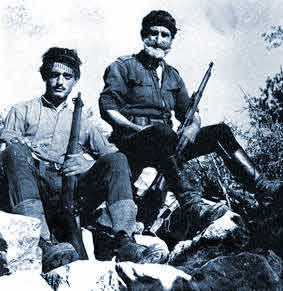 In late May 1941, Crete was the theater of the first major airborne assault in history. After a fierce and bloody conflict between Nazi Germany and the Allies that lasted ten days, the island fell to the Germans. However, despite their victory, the elite German paratroopers suffered such heavy loses that Adolf Hitler forbade further airborne operations of such large scale for the rest of the war. From the first days of the invasion, the local population organized a resistance movement, participating widely in guerrilla groups and intelligence networks. In reprisal, the Germans ordered numerous brutal attacks against Cretan civilians. Standing out among the list of atrocities, are the holocausts of Kedros (Amari) and Viannos, the destruction of Anogia and Kandanos and the massacre of Kondomari.
In late May 1941, Crete was the theater of the first major airborne assault in history. After a fierce and bloody conflict between Nazi Germany and the Allies that lasted ten days, the island fell to the Germans. However, despite their victory, the elite German paratroopers suffered such heavy loses that Adolf Hitler forbade further airborne operations of such large scale for the rest of the war. From the first days of the invasion, the local population organized a resistance movement, participating widely in guerrilla groups and intelligence networks. In reprisal, the Germans ordered numerous brutal attacks against Cretan civilians. Standing out among the list of atrocities, are the holocausts of Kedros (Amari) and Viannos, the destruction of Anogia and Kandanos and the massacre of Kondomari.